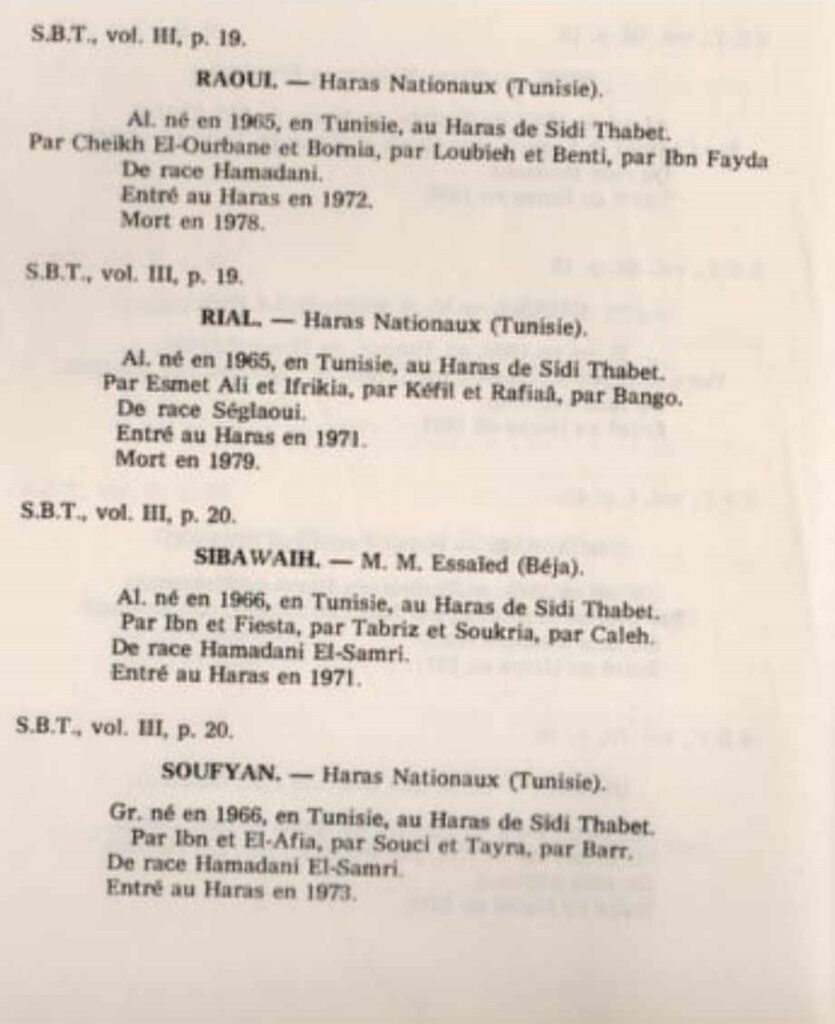Strain assignment in the Tunisian Studbook
Severine Vesco and I were doing some background work on the Tunisian sire lines today. We found that the Volume IV of the Tunisian Studbook (1977-8-9) had the strains of the horses assigned in the good-old-fashioned European way… by using the strain of the tail male ancestor.

The stallion Rial, for instance, was given the strain of “Seglaoui” while he was actually a Jilfan Dhawi, because his dam traces to Wadha. Rial goes back to the Tahawi-bred stallion Nasr in the sire line (Rial-Esmet Ali-Hazil-Fadjer-Nasr), and Nasr was a Saqlawi or “Seglaoui”, hence the mistake.
Similarly, the stallion Soufyan, was given the strain “Hamadani El-Samri”. That’s the strain of the desert-bred stallion in his sire line, a horse called Dynamite II. Dynamite II was himself recorded as being “de race Hamdani Semri”. The error becomes even more conspicuous when you notice that Soufyan and Sibawaih, the stallion right above him on the screenshot above, are assinged the same strain while tracing to two different dam lines, one to Mansourah, and the other to Emtayra.
Finally, the strain of the fourth stallion on the screenshot, Raoui, a head sire at the government stud, is listed as Hamdani. However, Raoui’s tail female is to the mare Yamouna, imported to the French government stud of Pompadour in 1876, and recorded as being “from a Najdi strain”. No Hamdani on that side. On the other hand, Raoui’s sire, the desert import Cheikh El Ourbane, is recorded as “Sire: A Hamdani, Dam: A Mouannakia, Importé en 1945 de Syrie.”
Whoever prepared that studbook, back in the late 1970s clearly did not know how Arabian strains worked. But that’s okay: even Prince Mohammed Ali Tewfik of Egypt, a recognized authority on the breed, didn’t (cf. Saklawi II, son of Saklawi I, but in reality a Dahman Shahwan).
MM , leads me to the question of since we know that the Dam gives the foal the mitochondrial dna, and then raises the foal and then teaches it all about the world, and how to relate to other herd members weren’t the Bedouin on to something when they emphasized the greater importance of the female lines?
best
Bruce Peek
Bruce Peek, I have often wondered the same.
Il est indispensable pour tout éleveur de pur sang arabe de connaître les fonctions principales de l’ADN mt, notamment en matière d’efforts physiques sur longues distances :
– cardiaque
– circulation sanguine, oxygénation du sang…
– production d’ATP, donc nutrition et nettoyage des cellules musculaires…etc…
Dans le domaine de l’endurance, la mère représente la “motorisation” du sportif !
Le choix de la lignée maternelle est déterminante pour les performances.
Bien entendu un mâle ne transmet pas son ADN mt (qui lui vient exclusivement de sa mère).
Seules les juments transmettent leur ADN mt.
Ce qui constitue une lignée maternelle spécifique.
J’ai constaté que fréquemment les performers en endurance ont un père et une mère issus de la même lignée maternelle.
Tout simplement en analysant les pedigrees des 15 ou 20 premiers sur une compétition. Et sur un grand nombre de compétitions chaque années.
C’est pour moi un fait remarquable et j’y attache beaucoup d’importance pour mes projets de croisement.
Je fais référence à la notion ancestrale des bédouins qui parlaient de croiser “dans le sang”. Au sens du sang issu de la même lignée maternelle.